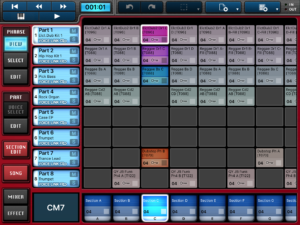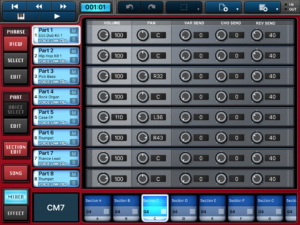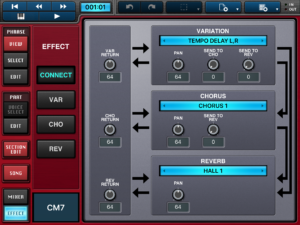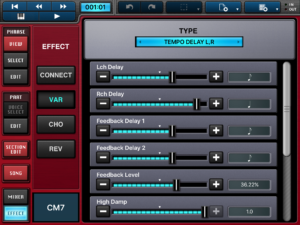In recent posts, I mentioned that Yamaha Mobile Music Sequencer (MMS) sends MIDI messages which conform to the XG voice and effects standard. Here’s a few screen shots to illustrate my observation.
The first thing everyone sees is the MMS Phrase Viewer. This is where you assemble phrases into sections. (It’s kind of like the Ableton Live Session View turned on its side.) Each section is a group of phrases which fit together musically and can be triggered together. [Click images to enlarge.] The song shown here is a rough attempt at Dub Reggae.
Each horizontal lane is a musical part. There are eight parts and they correspond to MIDI channels one to eight. Voice Link is enabled, so the voice for each part is determined by the pre-assigned voice for each phrase. MMS sends MIDI Bank Select MSB, Bank Select LSB and Program Change messages for each part. (See the Mobile Music Sequencer Reference page for more details including a list of voices.)
For this song, I used only six voices; that’s why there are two empty lanes. I intend to convert the song to a PSR/Tyros style. Thinking ahead, the parts 1 to 8 correspond to the Rhythm 1, Rhythm 2, Bass, Chord 1, Chord 2, Pad, Phrase 1 and Phrase 2 channels in a PSR/Tyros style. Enough about styles and style conversion for the moment.
When you tap the MIXER button, MMS displays its mixer view. From here, you can control the volume, pan, variation effect send, chorus effect send, and reverb send levels for each part.
These knobs are live. Each knob transmits its corresponding MIDI message as defined in the Yamaha XG architecture. The knobs transmit CC#7 volume, CC#10 pan, CC#94 variation send level, CC#92 chorus send level and CC#91 reverb send level. Thus, MMS does double-duty as a MIDI controller!
Tap the EEFECT button and MMS displays the effect connection view. This view shows the signal routing through the variation, chorus and reverb effect units. These knobs are live, too, and send XG MIDI messages to tweak the internal signal levels. This display is very handy if you’re an XG guy trying to spiff up a song.
The blue boxes with the left and right arrows select the effect algorithm assigned to the unit. (See the MMS Reference for details.) These buttons let you scoot quickly through different effects until you find the effect that strikes your fancy. MMS transmits the XG MIDI message to select the effect and it sends sixteen additional messages to set the effect parameters.
Speaking of effect parameters, tap the VAR button. (Tap CHO or REV.)
MMS displays sliders allowing you to tweeze the effect parameters. The screen shot (above) shows the parameters for the TEMPO DELAY effect algorithm.
Well, there you go. MMS is not only a sequencer, but it doubles as a MIDI controller. If you would like to know more, please read my earlier article Make music with MMS on PSR/TYROS.
Copyright © 2018 Paul J. Drongowski




